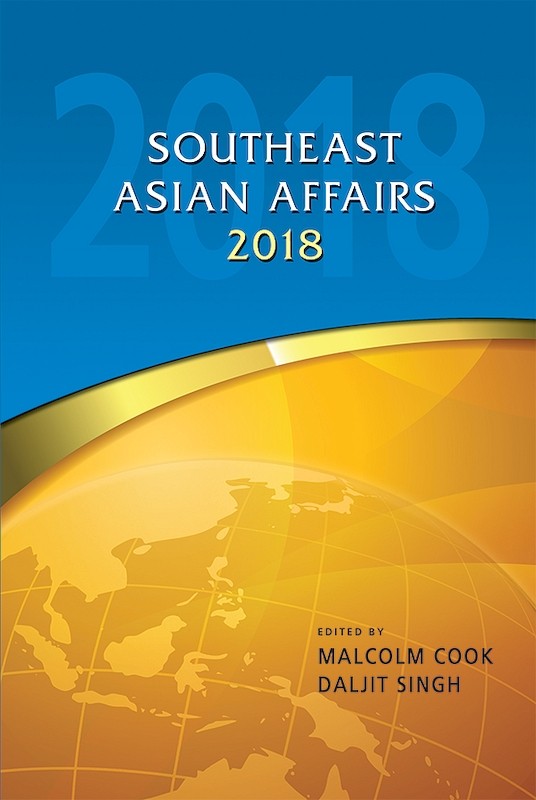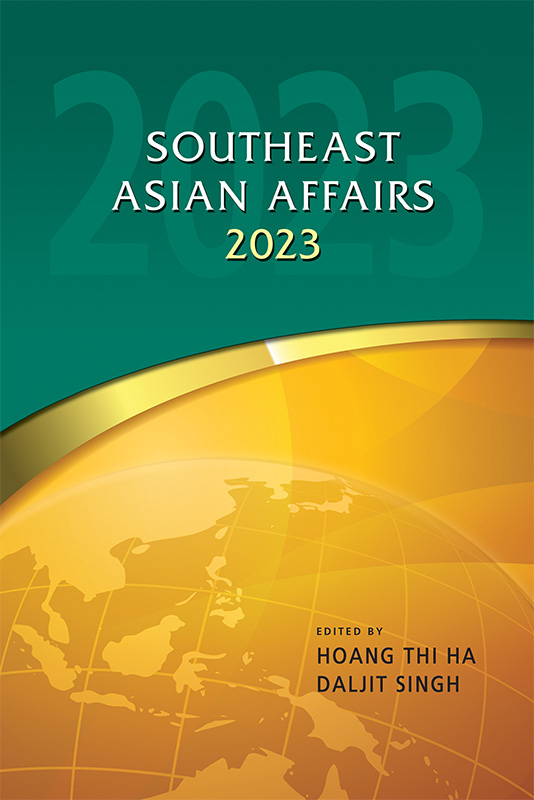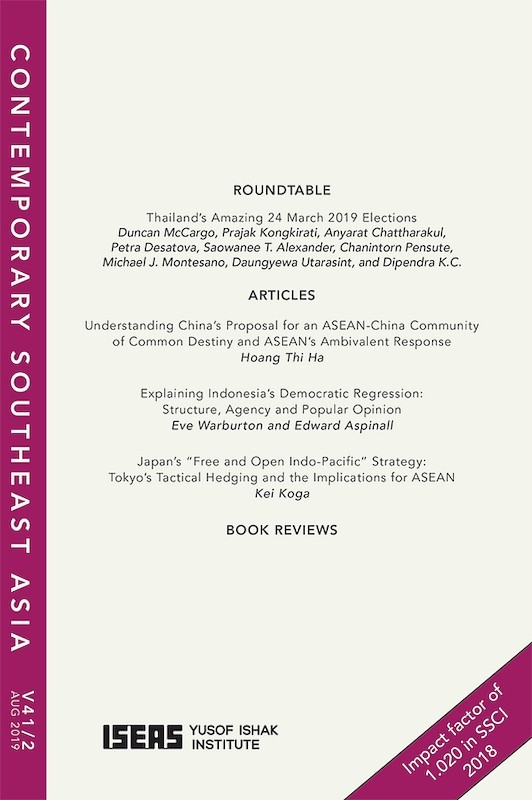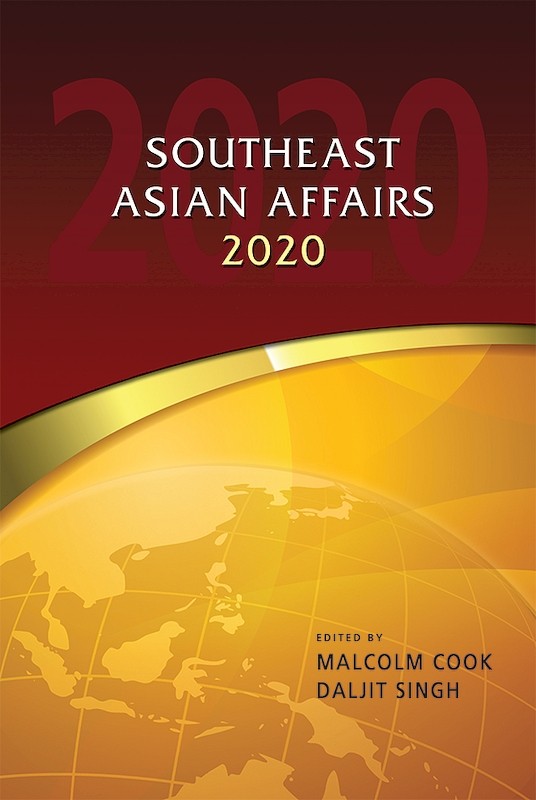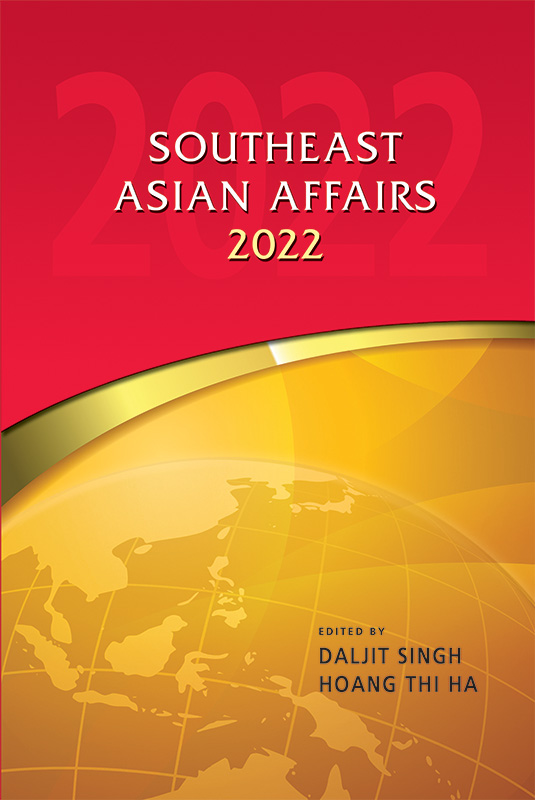Southeast Asian Affairs 2019
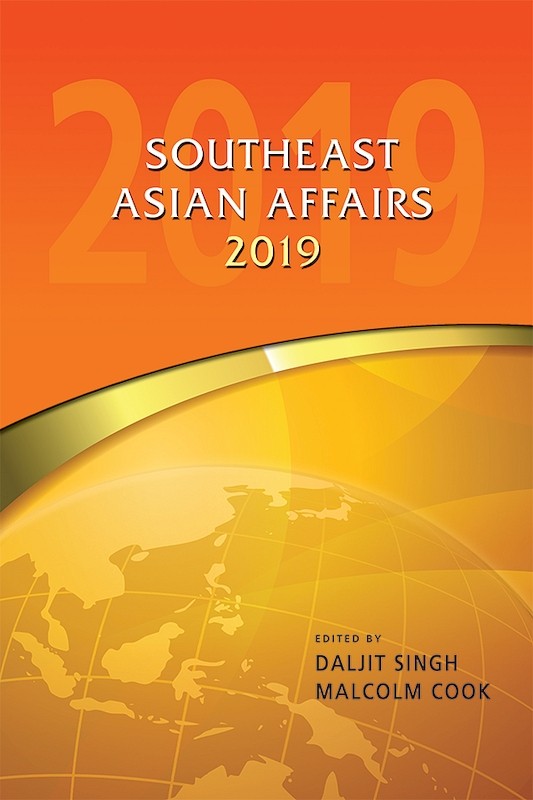
Date of publication:
2019
Publisher:
ISEAS – Yusof Ishak Institute
Number of pages:
411
Code:
SEAA19
Hard Cover
ISBN: 9789814843157
About the publication
“Southeast Asian Affairs, first published in 1974, continues today to be required reading for not only scholars but the general public interested in in-depth analysis of critical cultural, economic and political issues in Southeast Asia. In this annual review of the region, renowned academics provide comprehensive and stimulating commentary that furthers understanding of not only the region’s dynamism but also of its tensions and conflicts. It is a must read.”
– Suchit Bunbongkarn, Emeritus Professor, Chulalongkorn University
“Now in its forty-sixth edition, Southeast Asian Affairs offers an indispensable guide to this fascinating region. Lively, analytical, authoritative, and accessible, there is nothing comparable in quality or range to this series. It is a must read for academics, government officials, the business community, the media, and anybody with an interest in contemporary Southeast Asia. Drawing on its unparalleled network of researchers and commentators, ISEAS is to be congratulated for producing this major contribution to our understanding of this diverse and fast-changing region, to a consistently high standard and in a timely manner.”
– Hal Hill, H.W. Arndt Professor of Southeast Asian Economies, Australian National University
Contents
-
Southeast Asian Affairs 2019
[Whole Publication, ISBN: 9789814843164], by Daljit Singh, Malcolm Cook, editors -
Preliminary pages
- THE REGION
-
Challenges to Southeast Asian Regionalism in 2018, by Leszek Buszynski, author see abstract2018 was a year when ASEAN regionalism became increasingly challenged by trends and developments that it could not deal with on its own. First was the Rohingya issue which became increasingly internationalized. Second was the South China Sea which has become an issue for the US and China. Third was ASEAN’s promotion of a broader trade regime that would include its major trading partners and investors. ASEAN economies would benefit from their inclusion in these trade regimes whether the RCEP or the TPP but ASEAN centrality would be undermined. Fourth, the US-China trade war has exposed the vulnerabilities of the ASEAN economies to external shocks, some may benefit from the redirection of supply chains away from China but others will not. Fifth, the notion of the Indo-Pacific has been promoted by ASEAN’s partners as a broader basis for regional interaction that would include India. It threatens to displace Southeast Asia as the basis of ASEAN regionalism.
-
Regional Integration in Asia and the Pacific, and Dealing with Short and Long Term Challenges, by Jayant Menon, author see abstractComing into 2018, the outlook for the region was largely optimistic. Early in the year, the global trade slowdown, which started around 2010, appeared to have begun bottoming out, with East and Southeast Asia in particular leading the recovery. Unfortunately, more recent data suggests that the recovery in global trade may have been short-lived. Moreover, although the economic outlook for the region remains somewhat favourable, downside risks are on the rise. A number of critical changes are afoot. Many of the favourable conditions that have helped fuel the region’s successes may not hold in the short-term, while emerging trends such as population ageing and the fourth industrial revolution (4IR) bring with them new long-term opportunities as well as challenges. The region’s ability to evolve amidst these changes will determine whether it can continue to be a powerhouse in the global economy. This chapter examines the role which regional cooperation and integration (RCI) can play in this evolution.
-
Looking West, Acting East: India's Indo-Pacific Stategy, by Rohan Mukherjee, author see abstractThe re-emergence of the Indo-Pacific as a strategic concept guiding the foreign policies of the United States, Japan, Australia, and India—the so-called Quad—has raised concerns in Southeast Asia about ASEAN becoming less central in a region increasingly at risk of being dominated by dynamics reminiscent of the Cold War. However, one Quad member—India—is pushing for a more inclusive Indo-Pacific, one that would include both China and ASEAN. India’s different approach stems from New Delhi’s need to ‘manage’ Beijing through a mix of economic and diplomatic cooperation on the one hand and military deterrence on the other. Consequently, the Indo-Pacific as the conceptual basis for a potential China-focused containment strategy makes little sense to Indian policymakers. Instead, they prefer to dilute the threat to Beijing by involving more states in key regional discussions, and ASEAN is a logical candidate. However, Southeast Asian states looking for a major power that can support Washington’s declining ability to underwrite regional order cannot rely on New Delhi, which still pursues an ingrained foreign policy of strategic autonomy.
-
An Australian Vision of the Indo-Pacific and What It Means for Southeast Asia, by Rory Medcalf, author see abstractAustralia has been the most prominent and active proponent of the concept of the Indo-Pacific. Australia was the first country to formally introduce the Indo-Pacific as the official definition of its strategic environment in 2013. This has consistently been reaffirmed since, and elaborated in the 2017 Foreign Policy White Paper that provides a vision for Australia’s international relations. Some critics of the Indo-Pacific idea assume that it is essentially a “made-in-America” concept designed with the principal purpose of containing or at least balancing Chinese power. In fact, a closer look at Canberra’s version of the Indo-Pacific, most formally articulated in the Foreign Policy White Paper, suggests it has some authentically Australian characteristics, such as its encouragement of agency and cooperation among smaller and middle powers. Moreover, such a reading of Australia’s “new” Indo-Pacific strategy makes it suited for convergence with the imperatives of partner countries in Southeast Asia, and indeed with the Association of Southeast Asian Nations (ASEAN) as a whole.
-
The Trump Administration's Free and Open Indo-Pacific Approach, by Brian Harding, author see abstractAfter nearly two years, the Trump administration’s approach to the Indo-Pacific region has finally taken shape. Its objectives are a “Free and Open Indo-Pacific”, in line with decades of U.S. policy in the region, but in a new context of outright strategic competition with China. Its means include familiar tools of U.S. engagement, with some modest improvements for the times. But in Donald Trump’s America, actions often do not support stated goals and, in the case of policy in the Indo-Pacific, President Trump’s personal instincts, in particular his dogmatic approach to trade, have undermined his administration’s best efforts in the region.
-
Japan's "Free and Open Indo-Pacific Strategy" and Its Implication for ASEAN, by Tomohiko Satake, author see abstractIn August 2016, Japanese Prime Minister Shinzo Abe announced the “Free and Open Indo-Pacific Strategy” (FOIPs) at the Tokyo International Conference on African Development (TICAD) held in Kenya. Since then, many researchers and policymakers have discussed what the FOIP Strategy, and the broader concept ofa Free and Open Indo-Pacific (FOIP), exactly means. The chapter first examines why FOIPs has become an important strategic concept for Japan. It then argues that, while FOIPs is undeniably driven by the geopolitical concerns of Japanese policymakers, the reality (or its implementation) of FOIPs can be best described as a “regional order-building strategy”, rather than a mere geopolitical or geoeconomic strategy, aimed at establishing a pluralistic and inclusive order incorporating various regional countries under common rules and norms. As important elements of such a regional order-building strategy, the chapter highlights three aspects — (1) creating a stable (and multiple) power balance; (2) promoting regional resiliency, development and connectivity; and (3) rulemaking and norm-setting — that Japan has pursued under the name of FOIPs. After discussing these issues, the chapter examines the implications of FOIPs for ASEAN, and concludes that Japan’s cooperation with ASEAN will play a critical role for the success of FOIPs as a regional order-building strategy in order to avoid the emergence of a “new Cold War” in the region.
- BRUNEI DARUSSALAM
-
Brunei Darussalam: Making Strides with a Renewed Focus on the Future, by Mahani Hamdan, Chang-Yau Hoon, authors see abstractAfter four years of negative economic growth rates, Brunei’s economy gradually recovered to 1.329 per cent, turning positive for the first time in 2017 and continued to recover by 2.5 per cent in the first quarter of 2018. This was largely attributed to the non-oil and gas sector, particularly the private sector investments in infrastructure, and foreign direct investment in construction projects. The country’s economic diversification efforts have existed since the 1950’s, but until today, more than 50 per cent of its economic activities are still linked to the oil and gas industry. Avenues for economic diversification have been diverse, but actual implementation is complex and challenging. Brunei’s fiscal year 2018/19 budget focuses on five renewed thrusts: prudent spending; ease of doing business; enhancing productivity through innovation; creating employment opportunities and capacity-building; and preserving public welfare. This chapter provides brief reviews on the extent to which Brunei’s current economic activities focus on each of these thrusts, along with a discussion on key challenges that stand in the way of these goals being achieved. Through prudent fiscal management, the Brunei government is committed to reducing the country’s debt-to-GDP ratio to a lower level, eliminating deficits and returning to balanced budgets. There have also been an increasing number of Chinese companies invested in agriculture, halal food, aquaculture and bio-innovation through the Brunei-Guangxi Economic Corridor, and these projects promise more than 10,000 jobs to locals. Government agencies as well as private companies have put considerable efforts into promoting a conducive and supportive ecosystem to grow micro, small and medium enterprises (MSMEs). This requires ministries to be more proactive by improving coordination through the “Whole of Nation” approach at all levels. Improvements to health services, providing financial allowances for people with disability, and reducing poverty are given higher priority for achieving a high quality of life and a dynamic and sustainable economy towards Brunei’s Vision 2035. Overall, the economic outlook for Brunei in 2018 looks positive, reflecting stronger expansion of activities for greater economic dynamism.
- CAMBODIA
-
Cambodia in 2018: A Year of Setbacks and Successes, by Sorpong Peou, author see abstractCambodia in 2018 was marked by a number of major setbacks in some areas and successes in others. On the political front, the senate and parliamentary elections resulted in the Cambodian People’s Party’s monopolization of power within the bicameral legislature. Prime Minister Hun Sen continued to tighten his grip on power by taking steps to control state institutions, most notably the armed forces, the judiciary, and the party system. Human rights in the country continued to face an uphill battle, although the CPP government took a few small positive steps towards the end of the year by reversing its tight restrictions on the opposition and political rights. All these negative developments occurred despite positive signs of socio-economic development and international pressure from some major countries on which Cambodia has long depended for economic growth. Developed countries like the United States and those in Europe threatened to impose sanctions on Cambodia because of the election results, but the Hun Sen government did little to address their concerns about the political and human rights situation.
- INDONESIA
-
Indonesia in 2018: The Calm before the Election Storm, by Natalie Sambhi, author see abstractIn 2018 the key task of President Joko Widodo (Jokowi) was to keep the country on an even keel leading up to the 2019 presidential election. He faced a number of domestic challenges, from the Surabaya terrorist attacks, which saw children being used in suicide bombings for the first time, to the slew of major natural disasters in the second half of the year. The economy was rocked by volatile oil prices and the fallout from a trade war between the world’s largest economies, the United States and China, which led to the precipitous fall of the nation’s currency. The first section of this chapter discusses the significance of Ma’ruf Amin as Jokowi’s running mate and what it reveals about the prevailing political environment. It assesses Jokowi’s ability to navigate hosting the Asian Games while providing humanitarian relief to Indonesians affected by severe disasters. The second highlights the impact of the global environment on the economy as well as the Jokowi administration’s efforts to shore up trade and investment. The third section covers Indonesia’s attempts to promote its vision of the Indo-Pacific region as well as its steps towards leadership in diplomacy. The fourth outlines the major security issues, including the Surabaya terrorist attacks and the legislative changes they spurred, violent incidents such as the events in December 2018 in Nduga Regency, and maritime diplomacy. The final section traces the backsliding of Indonesia’s social and religious pluralism, particularly in terms of the impact of the changing demographic of conservative Muslims from lower to higher socioeconomic backgrounds.
-
Indonesia-China Relations: Coming Full Circle?, by Dewi Fortuna Anwar, author see abstractThe bilateral relations between Indonesia and the People’s Republic of China seem to have come full circle. The current state of relations between Jakarta and Beijing brings to mind the earlier period of close bilateral ties during the later years of President Sukarno’s presidency until his fall in late 1965. Although President Soeharto had already normalized relations with China in 1990 — after freezing diplomatic ties in 1967 — bilateral relations between Indonesia and China only improved significantly after the fall of Soeharto in mid-1998. Successive Indonesian presidents since the onset of the Reformasi era have placed great importance in forging closer relations with China, an increasingly important economic powerhouse as well as a major regional and global player. The momentum for enhanced cooperation between Indonesia and China gathered pace during the Yudhoyono presidency (2004–14) with the signing of the “Strategic Partnership” in 2005, which was then elevated to a “Comprehensive Strategic Partnership” in 2013. Under President Joko Widodo (popularly known as Jokowi), Indonesia-China relations have become even closer, especially in the economic field. China is now Indonesia’s most important trading partner and a major source of foreign investment for the government’s signature infrastructure projects, while Chinese tourists constitute the largest group of visitors to Indonesia. While the rapprochement between Indonesia and China is to be welcomed, and should be nurtured, it must be noted that this particular state of relations is being contested. President Joko Widodo has come under increasing criticism for not sufficiently protecting Indonesia’s wider national interests in his pursuit of Chinese foreign investment. Great care must therefore be taken to address all of the issues that have arisen. Left unattended they may jeopardize all the gains that have been made, which in turn could risk the return of the darker period of fraught Jakarta-Beijing relations.
- LAOS
-
Laos on the Path to Socialism?, by Boike Rehbein, author see abstractLaos in the period since 2016 is characterized by a return to a socialist rhetoric, which has come to the fore with the Prime Minister’s repeated calls for a policy of subsistence and self-reliance. This can be interpreted either as a reply to Chinese influence, an attempt to better control an increasingly complex society or an actual return to a socialist agenda. All three interpretations are correct but need to be complemented by the Lao and the Chinese perspectives. From China’s point of view, Laos can be one of the few partners, which gives the Lao leadership considerable manoeuvring space. For the Lao government, a socialist rhetoric allows it to mobilize the majority of the population against the centrifugal forces of capitalism and middle-class driven civil society.
-
Rent Capitalism and Shifting Plantations in the Mekong Borderlands, by Yos Santasombat, author see abstractThis paper examines the impact of China’s economic regionalism on sites of intensified resource extraction in the Mekong borderlands. A Chinese-driven banana boom and the penetration of overland Chinese entrepreneurs have turned farmland along the Mekong River on the Thai-Laos borders into banana production factories and export processing zones. It is argued that the Chinese banana industry’s practices of "shifting plantations" have transformed the Mekong into agricultural frontiers designed for specific and intensive regimes of resource extraction. Furthermore, in all banana plantations, vast quantities of pesticides, herbicides and fungicides are required to maintain monoculture production. This process poses a serious health risk to workers and the surrounding environment. After 6 to 10 years of producing fruit on cleared farmland, the company usually abandon it for another plot as soil depletion and pest infestation begin to lower yields. Since 2016, the government of Laos has issued a ban on new banana plantations. The shifting plantation practices, however, have spread to Thailand, Myanmar and Cambodia, causing health and environment damage along its path. The case of Chinese banana plantations in Laos is a striking example of some of the challenges posed by Beijing’s economic involvement in Southeast Asia.
- MALAYSIA
-
Malaysia in 2018: The Year of Voting Dangerously, by Geoffrey Kevin Pakiam, author see abstractThis chapter reviews one of the most dramatic years in Malaysia’s history. The country saw Mahathir Mohamed, at the grand old age of ninety-three, spearhead the electoral destruction of the political coalition he once helmed for over two decades. This upset was only made possible in turn by Mahathir’s reconciliation with his former political nemesis Anwar Ibrahim. The new Mahathir-led administration then spent the rest of the year trying to reconcile two conflicting priorities. The first involved setting the wheels of <i>Reformasi</i> into motion, and beginning to fulfil the long list of promises made in the run-up to elections. The second required the new government to perform damage control, and reassure conservative voters, investors, and foreign governments that little in Malaysia had fundamentally changed.
-
GE14 in East Malaysia: MA63 and Marching to a Different Drum, by James Chin, author see abstractWhile most scholars argued that 1MDB, Najib and kleptocracy, and the reputation of the United Malays National Organisation (UMNO) were key factors in the historical defeat of UMNO and the Barisan Nasional (BN) in the 2018 general elections, a key part of the shock election outcome has received scant attention: Sabah and Sarawak. If there is one single issue in East Malaysia that rallied the polity, it is the issue of the 1963 Malaysia Agreement (MA63) and the rise of state nationalism. In this chapter, I seek to explain how the MA63 issue became the mainstay of political debate and was the source of historical grievances and the political upheavals caused by the 2018 GE.
- MYANMAR
-
Myanmar in 2018: New Democracy Hangs in the Balance, by Morten B. Pedersen, author see abstractThe National League for Democracy (NLD) government has struggled to deliver on its promise of “change” since it swept into office with a landslide victory in the 2015 elections. The year 2018 saw a new push for reform, especially in the socio-economic arena. However, criticism of the government’s handling of the peace process and the Rohingya crisis only grew in volume during the year, and business confidence remained subdued. For the majority of people in the country, there was little improvement in their daily lives. The danger of persistent underperformance was brought home by the NLD’s relatively poor showing in the November by-elections. The NLD won seven of the thirteen seats contested but lost three seats that it previously held to the Union Solidarity and Development Party (USDP) and another one to the Chin League for Democracy, suggesting that its hold on power may be weakening as the 2020 elections loom ever larger on the horizon. Meanwhile, broader systemic threats to Myanmar’s new democracy are growing, both internally and externally.
-
Ethnicity, Citizenship and Identity in Post-2016 Myanmar, by Moe Thuzar, Darren Cheong, authors see abstractMyanmar has been experiencing less peaks than troughs in its transformation after Aung San Suu Kyi’s National League for Democracy (NLD), which won a landslide victory in the November 2015 polls, took office in 2016. The NLD inherited deep-seated legacies and prejudices, as well as a unique blend of political identity entrenched over seventy years of civil war. From 2016’s promise of being an annus mirabilis under a democratically elected government, Myanmar’s fledgling democracy experienced several challenges, particularly in getting the economy back on track amidst ongoing negotiations on power- and resource-sharing with ethnic armed organizations (EAOs), with whom the NLD’s predecessor administration had engaged in a nationwide ceasefire process.
- THE PHILIPPINES
-
Toxic Democracy? The Philippines in 2018, by Nicole Curato, author see abstractHas Philippine democracy assumed a toxic character in 2018? By focusing on the politics, policies, and deals of the Duterte administration, this chapter investigates the emerging legacy of the strongman in democratic institutions and public life. It focuses on key issues including harassment of media organizations, the ouster of the Supreme Court Chief Justice, the rehabilitation of Boracay and Marawi, and issues on Duterte's deals with China and new tax policy. These issues reveal a broader pattern of governance that shapes the trajectory of Philippine democracy.
-
The Rise of China, New Immigrants and Changing Policies on Chinese Overseas: Impact on the Philippines, by Teresita Ang-See, Carmelea Ang See, authors see abstractThe past decade has seen a sharp rise in the number of new immigrants from China into the Philippines, particularly in the past two years since the election of President Rodrigo R. Duterte in 2016. Some seek residency legally through investment and retirement visas or special working permits. The presence of the new Chinese immigrants has caused some tensions and complications in the Philippines, especially among the local ethnic Chinese community. The Chinese-Filipinos, or Tsinoys, sometimes find themselves embroiled in the popular discontent against China and Chinese immigrants. This is further complicated by China’s recent outreach efforts to the Chinese diaspora, which has been characterized by a relative lack of careful consideration about the distinction between Chinese nationals abroad and foreign nationals of ethnic Chinese descent.
- SINGAPORE
-
Singapore in 2018: Between Uncharted Waters and Old Ghosts, by George Wong, Woo Jun Jie, authors see abstractFor the city state of Singapore, 2018 was a year of many firsts. It marked the midpoint of the 13th Parliament of Singapore within a manifestly post–Lee Kuan Yew era. The incumbent government of the People’s Action Party (PAP) began the year with the pleasant surprise that economic growth in 2017 had reached 3.6 per cent. This exceeded the modest expectations of 1.5 to 3.5 per cent. But despite the positive start, 2018 was to be filled with headwinds for Singapore, both new and familiar. Top of the list was the revival of tensions with Malaysia, as well as a newly elected PAP Central Executive Committee, marking a crucial occasion of fourth-generation leadership transition for the world’s third-longest-ruling political party. On the international front it was the year of summits, with Singapore hosting two major events: the North Korea–United States Summit — the “Trump-Kim summit” — and the 33rd ASEAN Summit, both amidst the trade war between China and the United States. Meanwhile, in local politics, other notable firsts included the formation of the Select Committee on deliberate online falsehoods and the convening of its public hearings, as well as a cyberattack on SingHealth, Singapore’s largest healthcare provider, resulting in the records of about 1.5 million patients being compromised. On the ground, inequality took the crown as buzzword of the year in the public consciousness as Singapore grappled with various encounters, propelling the otherwise academic term into the limelight. On the policy side, the introduction of the Merdeka Generation Package set a new bar for the government’s commitment to reducing the healthcare costs of elderly Singaporeans.
- THAILAND
-
Thailand in 2018: Military Dictatorship under Royal Command, by Eugénie Mérieau, author see abstractThe military and the monarchy in Thailand remain powerful actors, even at times when there are regular elections and an alternation of civilian Governments. This suggests that Thailand is a tutelary democracy, which Adam Przeworski defines as “a regime which has competitive, formally democratic institutions, but in which the power apparatus, typically reduced to the armed forces, retains the capacity to intervene to correct undesirable states of affairs”. In Thailand, the tutelary powers, identified as the monarchy and the army, can veto decisions of elected politicians whenever needed, while allowing some degree of electoral politics to play out. Adopting a historical-institutional approach, this chapter analyses the Thai regime in terms of tutelary democracy, where tutelary powers as well as the mechanisms used by tutelary powers to veto decisions of elected politicians are entrenched through the constitution, laws and administrative structures created by laws. In that regard, the year 2018 was instrumental in setting the structures of continued military rule under a system of flawed electoral democracy for decades to come.
-
Competing Logics: Between Thai Sovereignty and the China Model in 2018, by Gregory V Raymond, author see abstractThis article examines the Thai military government's struggle to maintain balance between two opposing policy logics. On one hand, China has become not just a critical economic partner, but also a potential model of governance. On the other hand, Thailand’s resilient strategic culture and national identity each emphasize sovereignty and independence, requiring judicious diplomacy with the Great Powers as the primary tool to achieve these ends. This chapter assesses the extent to which 2018 might have been the high-water mark of Thailand’s embrace of China and its adoption of the China model.
- TIMOR-LESTE
-
Timor-Leste in 2018: An Eventful Year Ends in Tension, by Michael Leach, author see abstractFrom 25 January, when the president announced an early election for 12 May, it was clear 2018 would prove an eventful political year in Timor-Leste. The May election followed a nine-month Fretilin-led minority government that proved unable to steer its programme and budget through parliament, as the opposition parties formed a majority bloc a month after the government was installed. The election brought the Xanana Gusmão–led Alliance of Change for Progress (AMP) coalition back into office. Having taken power, the new government soon found itself mired in a standoff over ministerial appointments with the president, Fretilin’s Francisco Guterres, in the first genuine experience of cohabitation under Timor-Leste’s semi-presidential system. The year also saw an historic agreement between Timor-Leste and Australia that fixed maritime boundaries at the median line in the Timor Sea, thus ending a long-running dispute between the two nations. The year was capped off by the government outlining its bold vision for resource sovereignty, and its plan to purchase a majority share in the Greater Sunrise joint venture in order to advance its ambitious vision of downstream processing of oil and gas on the East Timorese south coast.
- VIETNAM
-
Vietnam in 2018: A Rent-Seeking State on Correction Course, by Alexander Vuving, author see abstractDoi moi was launched in 1986 to reform Vietnam’s totalitarian state, but instead of making Vietnam a new “Asian tiger”, it led to a rent-seeking state that nurtured rampant corruption and caused a prolonged period of economic slowdown. This rent-seeking state has been on a full correction course since 2016, but where will this path lead? This chapter examines the major developments in Vietnam’s domestic politics, economic life, and foreign relations that occurred in 2018 in order to assess the country’s trajectory. These developments include the attacks on the ‘Big Four’ rent-seeking networks in the political-business complex, a two-front battle against both corruption and liberalism, popular protests, leadership selection, developments regarding the drivers of economic growth, and Vietnam’s navigation of the geopolitical torrents.
-
Vietnam and Mekong Cooperative Mechanisms, by To Minh Thu, Le Dinh Tinh, authors see abstractRegional cooperation in the Mekong Basin has become increasingly dynamic in recent years with the emergence of new mechanisms and the reshuffling of existing ones. During the 1990s, Mekong cooperative efforts were primarily confined to the riparian countries. However, over the past ten years, as a result of its strategic location and growth potential, the Mekong Basin region has attracted the attention of major powers and developmental partners, including the United States, China, Japan, India and the European Union. The cooperative mechanisms both among riparian countries and with external partners have provided platforms for discussion of regional issues, especially water resource management, economic development and integration into the regional and global markets, regional connectivity, and addressing common challenges. This chapter will review the development of these major cooperative frameworks in the Mekong Basin and Vietnam’s proactive and comprehensive approach to these mechanisms, including the newly established Mekong-Lancang Cooperation framework.

